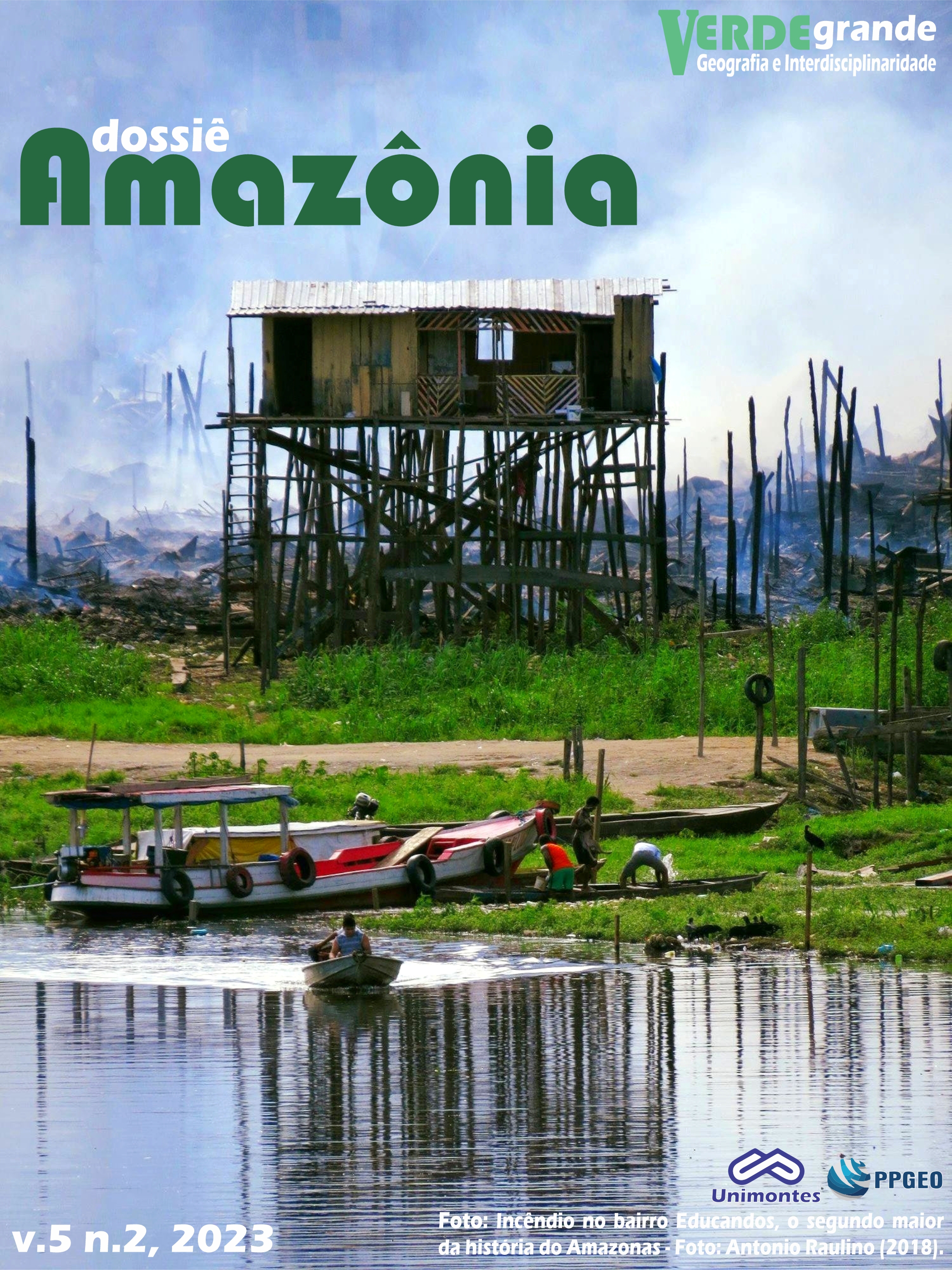O clima urbano na metrópole manauara: diferenças termohigrométricas no bairro do Coroado, Manaus-AM
DOI:
10.46551/rvg2675239520232152173Keywords:
Mobile transects, Urban climat, Heat island, ManausAbstract
The accelerated and unplanned urbanization process causes climatic disturbances, with significant potential to harm the quality of life of the urban population. In this sense, this work aimed to evaluate the variations of temperature and relative humidity of the air in the Coroado neighborhood, Manaus/AM. In addition to correlate with data of surface temperature and NDVI. The mobile transect was used as the main methodology for collecting temperature and humidity of the air data, with the aid of the thermo-hygrometer instrument. The collections occurred on July 15 to 19, 2022 in the period from 13 to 14 hours, the data were tabulated, statistically treated and analyzed from the constraints of the Coroado neighborhood, as well as were interpolated and mapped. From this, it is possible to infer that the densely urbanized area and the characteristics of land use and coverage are factors responsible for the thermal distribution within the intra-urban space, thus providing the occurrence of heat islands. In this way, the conditioning factors of the urban space are directly related to the thermal behavior of the surrounding atmosphere, so that the vegetation index has greater ability to modulate the thermal field of the neighborhood, and in turn, influences the quality of life of residents.
Downloads
References
ASSIS, W. L. O sistema clima urbano do município de Belo Horizonte na perspectiva têmporo-espacial. 299 f. Tese (Doutorado em Geografia). Instituto de Geociências. Universidade Federal de Minas Gerais, 2010.
BRICENO, J. L. P.; CÂNDIDO, L. A. Avaliação da Habilidade do Modelo WRF/UCM na Simulação do Clima Urbano de Manaus. Anais do V congresso de Iniciação Científica do INPA-CONIC, 2016. pp. 157-161.
COOK, M. J. Atmospheric Compensation for a Landsat Land Surface Temperature Product. Tese (Doutorado): Instituto de Tecnologia de Rochester, 2014.
DUBREUIL, V.; FANTE, K. P.; PLANCHON, O.; SANT’ANNA NETO, J. C. Os tipos de climas anuais no Brasil: uma aplicação da classificação de Köppen de 1961 a 2015. Confins, n. 37, 2018. DOI: https://doi.org/10.4000/confins.15738
FERREIRA, M. C. Iniciação à análise geoespacial: teoria, técnicas e exemplos para geoprocessamento. São Paulo: Editora Unesp, 2013.
GARTLAND, L. Ilhas de calor: como mitigar zonas de calor em áreas urbanas. Tradução de Silvia Helena Gonçalves. São Paulo: Oficina de Textos, 2010.
HIDORE, J. J.; OLIVER, J. E. Climatology: an atmospheric science. 2. ed. New Jersey: Prentice Hall, 2002. 410p.
JENSEN, J. Sensoriamento remoto do ambiente: uma perspectiva em recursos terrestres. São José dos Campos: Editora Parêntese, 2009.
LIMA, N. R. de; PINHEIRO, G. M.; MENDONÇA, F. Clima urbano no Brasil: Análise e contribuição da metodologia de Carlos Augusto de Figueiredo Monteiro. Revista Geonorte, v. 3, n. 9, 2012.
LOMBARDO, M. A. Ilha de Calor nas Metrópoles: O exemplo de São Paulo. São Paulo: Hucitec, 1985.
MENDONÇA, F. A. O estudo do clima urbano no Brasil. In: MONTEIRO, C. A. de F.; MENDONÇA, F. Clima urbano. 2. ed. São Paulo: Contexto, 2003. pp. 175-190.
MONTEIRO, C. A. F. Teoria e clima urbano. 25. São Paulo: IGEOG/USP, 1976. 181p. (Série Teses e Monografias, 25).
MONTEIRO, C. A. de F. Clima Urbano. 2. ed. São Paulo: Editora Contexto, 2003.
MULLER, J. Orientação básica para o manejo de arborização urbana. Edições FAMURS. Porto Alegre: Nova Prova, 1998.
MURARA, P. G. Técnicas de interpolação para a pesquisa em climatologia regional e agroclimatologia. Revista Brasileira de Climatologia. Ano 15 – Edição Especial – XIII Simpósio Brasileiro de Climatologia Geográfica, 2019. DOI: http://dx.doi.org/10.5380/abclima.v0i0.66602
NIMER, E. Climatologia do Brasil. 2. ed. Rio de Janeiro: IBGE – Departamento de Recursos Naturais e Estudos Ambientais, 1989.
OLIVEIRA, J. A. de. Manaus de 1920-1967: a cidade dura e doce em excesso. Manaus: Editora Valer - Governo do estado do Amazonas (Editora da Universidade Federal do Amazonas), 2003. 176p.
OLIVEIRA, J. A. de; COSTA, D. P. da. A análise da moraria em Manaus (AM) como estratégia de compreender a cidade. Revista Eletrónica de Geografía y Ciencias Sociales. Universidad de Barcelona. v. XI, n. 245 (30), 2007.
OLIVER, J. E.; HIDORE, J. J. Climatology. An atmospheric science. Prentice Hall, 2002.
SILVA, F. B. A; VIDAL, B. S.; MELO, F. M. Produção do espaço e ilhas de calor superficiais em Manaus: Notas sobre os bairros Dom Pedro e Coroado. In: SANTANA, Artur Silva de et al. (Org.). Anais do VI Encontro de Pós-Graduação. Instituição de Ensino Superior em Marabá, out, 2021.
SOUZA, A. M. B. de et al. Ferramentas para caracterização de área urbana resultado de diferentes processos de ocupação. In: Proceedings of Safety, Health and Environment World Congress, 2013. pp. 309-312.
VALIN JUNIOR, M. de O.; SANTOS, F. M. de M. Levantamento bibliográfico da utilização de transectos em pesquisas de clima urbano no brasil e recomendações de padronização nos procedimentos. Revista Brasileira de Climatologia, v. 26, abr. 2020. DOI: http://dx.doi.org/10.5380/abclima.v26i0.67231
Downloads
Published
How to Cite
Issue
Section
License
Copyright (c) 2023 Bruno Sarkis Vidal, Kemyla de Oliveira França Andrade, Bianca Silva de Souza, Leandro Félix de Castro

This work is licensed under a Creative Commons Attribution-NonCommercial-NoDerivatives 4.0 International License.
You are free to:
Share — copy and redistribute the material in any medium or format
The licensor cannot revoke these freedoms as long as you follow the license terms.
Under the following terms:
Attribution — You must give appropriate credit, provide a link to the license, and indicate if changes were made. You may do so in any reasonable manner, but not in any way that suggests the licensor endorses you or your use.
NonCommercial — You may not use the material for commercial purposes.
NoDerivatives — If you remix, transform, or build upon the material, you may not distribute the modified material.
No additional restrictions — You may not apply legal terms or technological measures that legally restrict others from doing anything the license permits.


















 Esta obra está licenciada com
Esta obra está licenciada com 